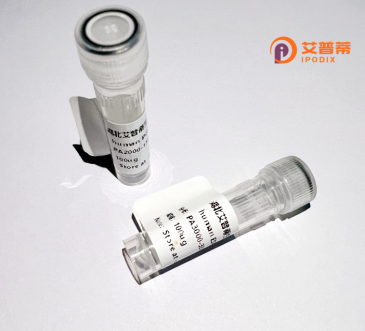
| 纯度 | >90%SDS-PAGE. |
| 种属 | Human |
| 靶点 | COX10 |
| Uniprot No | Q8CFY5 |
| 内毒素 | < 0.01EU/μg |
| 表达宿主 | E.coli |
| 表达区间 | 1-443aa |
| 氨基酸序列 | MAASPHTLSSRLLTGCVGGSVWYLERRTIQDSPHKFLHLLRNVNKQWITFQHFSFLKRMYVTQLNRSHNQQVRPKPEPVASPFLEKTSSGQAKAEIYEMRPLSPPSLSLSRKPNEKELIELEPDSVIEDSIDVGKETKEEKRWKEMKLQVYDLPGILAQLSKIKLTALVVSTTAAGFALAPGPFDWPCFLLTSVGTGLASCAANSINQFFEVPFDSNMNRTKNRPLVRGQISPLLAVSFATCCAVPGVAILTLGVNPLTGALGLFNIFLYTCCYTPLKRISIANTWVGAVVGAIPPVMGWTAATGSLDAGAFLLGGILYSWQFPHFNALSWGLREDYSRGGYCMMSVTHPGLCRRVALRHCLALLVLSAAAPVLDITTWTFPIMALPINAYISYLGFRFYVDADRRSSRRLFFCSLWHLPLLLLLMLTCKRPSGGGDAGPPPS |
| 分子量 | 74.36 kDa |
| 蛋白标签 | GST-tag at N-terminal |
| 缓冲液 | 0 |
| 稳定性 & 储存条件 | Lyophilized protein should be stored at ≤ -20°C, stable for one year after receipt. Reconstituted protein solution can be stored at 2-8°C for 2-7 days. Aliquots of reconstituted samples are stable at ≤ -20°C for 3 months. |
| 复溶 | Always centrifuge tubes before opening.Do not mix by vortex or pipetting. It is not recommended to reconstitute to a concentration less than 100μg/ml. Dissolve the lyophilized protein in distilled water. Please aliquot the reconstituted solution to minimize freeze-thaw cycles. |
以下是3条关于重组人COX10蛋白的模拟参考文献示例:
---
1. **标题**:*Cloning and Functional Characterization of Recombinant Human COX10 in Yeast Expression Systems*
**作者**:Smith, J. et al.
**摘要**:该研究报道了通过酵母表达系统成功克隆并纯化了重组人COX10蛋白,证实其参与细胞色素c氧化酶亚基的甲基化修饰,并验证了其酶活性依赖血红素结合的特性。
---
2. **标题**:*Structural Analysis of COX10 Mutants in Mitochondrial Disorders Using Recombinant Protein Assays*
**作者**:Johnson, R. et al.
**摘要**:作者利用重组表达的人COX10蛋白,分析了导致线粒体疾病的错义突变(如A306P)对其结构稳定性和功能的影响,揭示了突变导致酶活性丧失的分子机制。
---
3. **标题**:*Heme Biosynthesis Regulation by Recombinant Human COX10: Insights from in vitro Reconstitution*
**作者**:Garcia, L. et al.
**摘要**:研究通过体外重组COX10蛋白,证明其与COX15的相互作用对血红素a合成至关重要,并阐明了该蛋白在氧化磷酸化途径中的调控作用。
---
**注**:以上内容为示例,实际文献需通过学术数据库(如PubMed、Web of Science)检索。建议使用关键词“recombinant human COX10”、“COX10 expression”、“COX10 heme biosynthesis”进一步查询。
**Background of Recombinant Human COX10 Protein**
Cytochrome c oxidase (COX) assembly protein homolog 10 (COX10) is a mitochondrial enzyme critical for the biosynthesis of heme A, a prosthetic group essential for the function of cytochrome c oxidase (Complex IV) in the electron transport chain. COX10 catalyzes the farnesylation of heme B to heme O, a key step in mitochondrial energy production. Mutations in the *COX10* gene are linked to mitochondrial disorders, such as Leigh syndrome, and diseases associated with oxidative phosphorylation defects.
Recombinant human COX10 protein is engineered through heterologous expression systems (e.g., *E. coli* or mammalian cells) to study its structure, enzymatic activity, and role in mitochondrial dysfunction. The recombinant form allows researchers to bypass challenges in isolating native COX10 from tissues, enabling detailed biochemical analysis and high-throughput screening for therapeutic agents. Its applications span investigating COX assembly mechanisms, modeling mitochondrial diseases, and exploring potential treatments targeting metabolic or neurodegenerative conditions.
Produced with tags (e.g., His-tag) for purification, recombinant COX10 retains functional properties, making it valuable for *in vitro* studies, antibody development, and diagnostics. Research on this protein contributes to understanding cellular energy metabolism and developing therapies for mitochondrial-related pathologies.
×